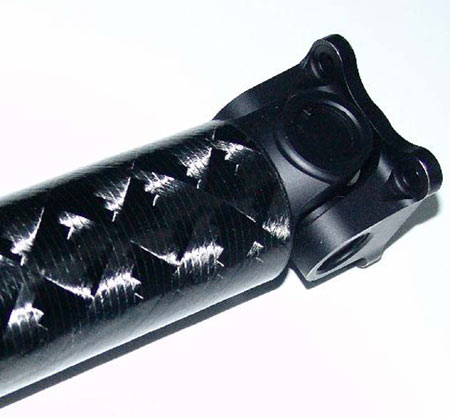Composite prop shafts
GT racing is one of the most challenging motorsport disciplines in terms of the demands it places on components, especially transmissions. These need to be able to deal with a wide range of conditions, from those experienced during short sprint races to full endurance epics such as the Le Mans 24 Hours. One area that is often overlooked though is the means for transmitting drive from the engine to the gearbox, specifically in front-engined, rear-wheel-drive cars. The generally accepted way of achieving this transfer is through the use of a prop shaft, a solution that dates from pretty much the dawn of the automobile.
The forces the shaft is subjected to are substantial, so for many years the only option was to use metallic materials - usually steel or in some cases aluminium - for their construction. Despite providing the strength required to achieve the durability needed with high-output race engines, especially when used for endurance racing applications, metallic prop shafts have some disadvantages. Notably they are heavy, which adds to vehicle weight and increases parasitic power losses, but more important the material choice severely limits the maximum shaft length used in high-rpm applications.
This is due to the bending resonance experienced by a tube as it reaches its critical speed. This resonance is described by the following equation:

where:
Nc is the critical shaft speed
L is the shaft length
I is the tube's second moment of area
A is the cross-sectional area of tube
C is the constant vibration
E/ñ is the specific modulus of the shaft material
The resonance will destroy a prop shaft, and while that's not a huge problem on low-revving mainstream automobiles, it is a serious issue in high-speed race applications. The only ways to increase the critical speed are to increase the diameter of the tubing or increase the specific modulus of the material. Space constraints invariably set a limit the diameter of the tube, while it is an interesting characteristic of metals that the specific modulus is approximately constant, despite big differences in density.
One driveshaft manufacturer discovered that at a speed of 8000 rpm the longest steel shaft that could be used before resonance became a problem was only 1250 mm. This is too short for most applications, so the general approach is to use a two-piece shaft with a supported joint in the middle. Evidently from a racing perspective, that is not ideal, as it introduces both extra weight and complexity into the system.
The solution to this problem was the introduction of composite prop shafts, the use of which has been made possible by advances in materials technology. By using fibre-reinforced composites, it is possible to orientate the fibres in a tube's structure so that the bending modulus has a high value (above 100 GPa) while the specific gravity is low (below 1.6). This leads to a favourable specific bending modulus and enhanced critical speed.
This is not a particularly new idea, and the first composite shafts began to appear in production cars in the late 1980s, although these used an aluminium core reinforced with a carbon fibre outer sleeve. Composite prop shafts were experimented with in the 1990s in rallying and circuit racing, but there were many failures. However, the past decade has seen great improvements in both composite materials technology and, more important, the ability to simulate and assess different construction techniques. The result is that nearly all competition GT cars now feature composite shafts, which have proved to be more than up to the required tasks.

Making these shafts is a complex process, and predominantly uses a filament-wound carbon tube for the main structure. Manufacture involves winding filaments under varying amounts of tension over a male mould, or mandrel. The mandrel rotates while a carriage moves horizontally, laying down fibres in the desired pattern. The exact pattern of the 'lay-up' will be determined using FEA software and specialist composite CAE packages, to ensure the fibres are oriented in the optimum direction to absorb loadings. The connections at the tube's ends are usually a very tight interference fit, and bonded to the tube with high-strength resin.
The overall result is impressive. One manufacturer says a representative 1.5 m prop shaft for GT use weighs only 2 kg, compared to about 10 kg for a similar two-piece steel item. Yet despite the low weight the shaft can still withstand up to 3500 Nm of torque while operating in an environment at 100 C. This represents a major improvement in both overall vehicle weight and rotating mass, and makes it easy to see why nearly all front-engined, rear-wheel-drive GT cars now run composite props.
Fig. 1 - Composite prop shaft for use in endurance racing
Written by Lawrence Butcher